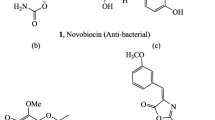Abstract
Diabetes mellitus, a metabolic disorder, is characterized by a substantial hyperglycaemia. Prevalence of hyperglycaemia for longer period of time can cause nonenzymatic condensation of sugar in blood with amino group of protein and give rise to advanced glycation end products (AGEs). AGEs play a major role in the onset of late diabetic complications including diabetic retinopathy, nephropathy, neuropathy and cardiovascular diseases. There is a need to establish potential therapeutic regimens that can effectively inhibit the formation of AGEs. To this end a series of novel oxindole-based chalcones have been investigated for their antiglycation potential. Analogues 1 (IC50 = 155.22 ± 2.98 µM), 3 (IC50 = 195.95 ± 0.43 µM), 4 (IC50 = 289.47 ± 2.47 µM), 5 (IC50 = 222.44 ± 4.03 µM), 7 (IC50 = 251.27 ± 2.80 µM), and 20 (224.23 ± 1.93 µM) showed potent inhibitory activity against glycation compared to the reference Rutin (IC50 = 294.5 ± 1.5 µM). These results reveal that multiple hydroxyl substituents and their position on the aromatic ring play a key role in inhibitory effect due to their hydrogen bonding potential. The study also reveals the influence of substituents on the binding capabilities and in turn inhibitory potential of different analogues.





Similar content being viewed by others
References
Ahmed N (2005) Advanced glycation endproducts—role in pathology of diabetic complications. Diabetes Res Clin Pract 67:3–21
Cervantes-Laurean D, Schramm DD, Jacobson EL, Halaweish I, Bruckner GG, Boissonneault GA (2006) Inhibition of advanced glycation end product formation on collagen by rutin and its metabolites. J Nutr Biochem 17:531–540
Cooper ME (2004) Importance of advanced glycation end products in diabetes-associated cardiovascular and renal disease. Am J Hypertens 17:31S–38S
Danaei G, Finucane MM, Lu Y, Singh GM, Cowan MJ, Paciorek CJ, Lin JK, Farzadfar F, Khang Y-H, Stevens GA (2011) National, regional, and global trends in fasting plasma glucose and diabetes prevalence since 1980: systematic analysis of health examination surveys and epidemiological studies with 370 country-years and 2·7 million participants. The Lancet 378:31–40
Furth A (1997) Glycated proteins in diabetes. Brit J Biomed Sci 54:192–200
Kadin SB (1985) 3-Substituted 2-oxindole-1-carboxamides as analgesic and anti-inflammatory agents. US Patent 4,556,672.
Kaur H, Kamalov M, Brimble MA (2016) Chemical synthesis of peptides containing site-specific advanced glycation endproducts. Acc Chem Res 49:2199–2208
Khan KM, Khan M, Ambreen N, Taha M, Rahim F, Rasheed S, Saied S, Shafi H, Perveen S, Choudhary MI (2013) Oxindole derivatives: synthesis and antiglycation activity. Med Chem 9:681–688
Kornet MJ, Thio AP (1976) Oxindole-3-spiropyrrolidines and-piperidines. Synthesis and local anesthetic activity. J Med Chem 19:892–898
Maillard LC (1912) Action of amino acids on sugars. Formation of melanoidins in a methodical way. Cr Acad Sci 154:66–68
Méndez JD, Xie J, Aguilar-Hernández M, Méndez-Valenzuela V (2010) Trends in advanced glycation end products research in diabetes mellitus and its complications. Mol Cell Biochem 341:33–41
Miyata T (1996) New aspects in the pathogenesis of dialysis-related amyloidosis: pathophysiology of advanced glycation end products in renal failure. Nihon Jinzo Gakkai shi 38:191–197
Peddibhotla S (2009) 3-Substituted-3-hydroxy-2-oxindole, an emerging new scaffold for drug discovery with potential anti-cancer and other biological activities. Curr Bioact Compd 5:20–38
Peppa M, Uribarri J, Vlassara H (2003) Glucose, advanced glycation end products, and diabetes complications: what is new and what works. Clin Diabetes 21:186–187
Raj DS, Choudhury D, Welbourne TC, Levi M (2000) Advanced glycation end products: a nephrologist’s perspective. Am J Kidney Dis 35:365–380
Schmidt AM, Du Yan S, Stern DM (1995) The dark side of glucose. Nat Med 1:1002–1004
Shaw J, Sicree R, Zimmet P (2010) Global estimates of the prevalence of diabetes for 2010 and 2030. Diabetes Res Clin Pract 87:4–14
Singh VP, Bali A, Singh N, Jaggi AS (2014) Advanced glycation end products and diabetic complications. Korean J Physiol Pharmacol 18:1–14
Strigacova J, Hudecova D, Mikulášová M, Lásiková A, Végh D (2001) Novel oxindole derivatives and their biological activity. Folia Microbiol 46:187–192
Taha M, Ismail NH, Khan A, Shah SAA, Anwar A, Halim SA, Fatmi MQ, Imran S, Rahim F, Khan KM (2015) Synthesis of novel derivatives of oxindole, their urease inhibition and molecular docking studies. Bioorg Med Chem Lett 25:3285–3289
Thorpe S, Baynes J (2003) Maillard reaction products in tissue proteins: new products and new perspectives. Amino Acids 25:275–281
Woods TM, Kamalov M, Harris PWR, Cooper GJS, Brimble M (2012) Synthesis of monolysyl advanced glycation endproducts and their incorporation into collagen model peptides. Org Lett 14:5740–5743
Zhang X, Breslav M, Grimm J, Guan K, Huang A, Liu F, Maryanoff CA, Palmer D, Patel M, Qian Y, Shaw C, Sorgi K, Stefanick S, Xu D (2002) A new procedure for preparation of carboxylic acid hydrazides. J Org Chem 67:9471–9474
Author information
Authors and Affiliations
Corresponding authors
Ethics declarations
Conflicts of Interest
The authors declare no conflict of interest.
Additional information
Publisher’s note: Springer Nature remains neutral with regard to jurisdictional claims in published maps and institutional affiliations.
Rights and permissions
About this article
Cite this article
Khan, A., Khan, A., Farooq, U. et al. Oxindole-based chalcones: synthesis and their activity against glycation of proteins. Med Chem Res 28, 900–906 (2019). https://doi.org/10.1007/s00044-019-02345-1
Received:
Accepted:
Published:
Issue Date:
DOI: https://doi.org/10.1007/s00044-019-02345-1




